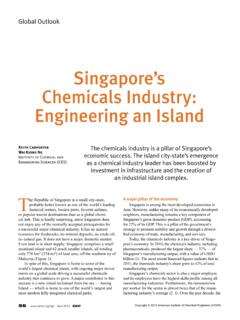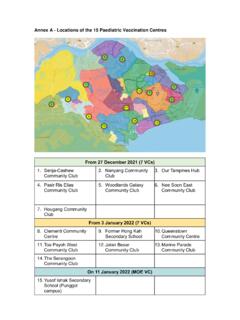Transcription of Singapore Geology And Its Impact on Underground ...
1 Jeyatharan Kumarasamy Singapore Geology And Its Impact on Underground Construction Works Singapore Geology Some characteristics of Singapore soils and rocks Construction methods Deep excavations Tunnelling Construction challenges Deep excavations Tunnelling Conclusions Content Singapore Surface Geology Map Bukit Timah Granite Formation jurong Formation Old Alluvium Formation Kallang Formation Major Geological Formations in Singapore oExistence of corestones/ boulders depends on the minerals of the original rock and the weathering agents oSize of corestones/boulders vary Bukit Timah Formation oSurface weathered to residual soil (mainly sandy clayey silt); depth to bedrock varies from 3m to up to 70m with an average depth of 30m oThere is often, but not always, corestone/boulder encountered within GVI to GV oAverage uniaxial compressive strength of intact rock is about 190 MPa but could be as high as 400 MPa oThere are 4 to 5 joint sets ranging from sub horizontal to sub vertical.
2 Dominant joint set is sub vertical oInterface between soil and rock is highly variable within short distance and the change in strength of soil to that of rock is very drastic oThere is often, but not always, a zone (typically to 2m thick) of permeable (1 x 10-5 to 10-6 m/s) GIV to GV immediately overlying the rock grades Bukit Timah Formation Geological Faults in Singapore oOrigin was dated late Triassic to possibly early Jurassic and overlies the Granite. It exists mostly at western and southern parts of Singapore oSeven sedimentary facies, including one that is characterised by limestone, are recognised within the formation oFurther geological activity in early Tertiary, late Tertiary and early Pleistocene caused beds of jurong Formation variably folded and fauted; 3 major thrust faults and numerous small scale faults jurong Formation oDue to folding/faulting, the sequence of rock vary significantly oHighly weathered rock could be below less weathered rock jurong Formation oConsists of a variety of sedimentary rocks.
3 Sandstone, siltstone, mudstone, limestone etc oDegree of weathering depends on rock types, sandstone more resistive to weathering than mudstone oStrength of rock depends on rock type and weathering stage oResidual soils are mainly silty clay jurong Formation jurong Formation - Limestone jurong Formation - Limestone jurong Formation - Limestone Borehole Logs along Gridline D PSA s 3rd Container Terminal at Pasir Panjang jurong Formation - Limestone jurong Formation - Limestone Concrete level Vs Concrete volume in a bored pile construction a bridge project at the Pandan Reservoir jurong Formation - Limestone Borehole (cavity filed with mortar) Additional holes to check infill Investigation of cavity during bored piling works at PSA s 3rd Container Terminal Pasir Panjang jurong Formation - Limestone Or this? Could it be like this? jurong Formation - Limestone oFCBB is a colluvial deposit of slipped material of Rimau Facies of JF triggered by seismic activity oIt was probably laid down in late Cretaceous, but could be anytime between JF deposited and OA was first deposited Fort Canning Boulder Bed (FCBB) oComprising generally lens-shaped or rounded fresh sandstone boulders ranging 1 to 9m in a hard, multi-coloured, mainly red and white silty clay oThe content of boulders in the FCBB varies at different locations from 10% to 40% with an average of 20% Fort Canning Boulder Bed (FCBB) oExist in CBD district of Downtown Singapore oExist above JF but below OA/Kallang Fort Canning Boulder Bed (FCBB)
4 OIn late Tertiary, a downwarp occurred and the resulting trough was back-filled with a coarse sand-gravel unit referred to as the Old Alluvium oThe base of OA is below base level associated with Pleistocene low sea levels, and its top associated with minimum high sea level of 70m Old Alluvium Formation Old Alluvium Formation oExits mostly at eastern parts of Singapore oGenerally it overlies on Granite. Granite ridges found beneath OA at some areas oHowever, it was laid down against Sajahat formation in the north near Punggol, jurong formation in Sungei Buloh Besar, FCBB in CBD area oDepth up to 195m Old Alluvium Formation oMedium dense to very dense clayey/silty coarse sand and fine gravel and lenses of silt and clay oSurface weathered and much of cementation lost as a result oPotential existence of high permeable sand lenses Old Alluvium Formation oAppears in cohesive and granular layers and its behaviour varies accordingly Old Alluvium Formation oOA has pockets of sand, confined aquifers and beds of permeable cemented sands.
5 OPebble within OA are dominantly quartz (generally more angular) but rhyolite, chert and argillite pebbles (rounded) are also found Old Alluvium Formation oZone of cementation are found but cemented rock disintegrates after few days of exposure. oHowever some areas of cemented OA have been exposed for several years and yet remained cemented. Old Alluvium Formation oYoungest deposit; Alluvial, littoral and inshore marine sediments have been laid down from late Pleistocene to Holocene period ocould be up to 55m deep; generally low lying and seldom recognised more than 4m above sea level oincludes marine clay, fluvial clay, fluvial sand, and estuarine Kallang Formation Kallang Formation oMarine clay / estuarine is very soft and highly compressible whereas fluvial clay is stiff oWhere Kallang is thick, marine clay could appear in two layers: upper and lower layers separated by fluvial deposits oLoose fluvial sand (F1) is highly permeable oLarge consolidation settlement could be expected due to additional loads or water drawdown Kallang Formation oReclamation was carried out in several phases over the years oCut OA material was used in earlier phases and imported sands are used in later phases of reclamation oMarine clay underneath is still under going consolidation oAbandoned and buried structures exist within reclamation fill Reclamation Fill Construction Methods Slope Excavation Seldom adopted in Singapore due to site constraints Not appropriate in sandy soils or fractured rocks Steeper slopes could be achieved with soil nails/ rock dowels Braced Excavation Braced Excavation Choices of Retaining Systems Types of temporary Retaining Wall systems Sheetpile/ Soldier Pile/ Steel Pipe Pile Contiguous Bored Pile/ Secant Pile Diaphragm Wall Types of bracing systems Strutting Soil Nails/Ground Anchor Types of Ground Improvement Jet Grouting Deep
6 Soil Mixing Ras Jet Method Chemico-Lime Piles passive D active NET PRESSURE ON WALL ( active passive) Hard Soil Soft Soil span passive D active Sheet Pile + Soldier Pile Wall Contiguous Bored Pile / Secant Pile Wall Contiguous Bored Pile (CBP) Secant pile wall Contiguous Bored Pile Wall One North Station Diaphragm Wall Excavation - Race Course Road Beam mounted jet grout rigs working adjacent to Race Course Road EXISTING BUILDING 23 522 CHEMICO-LIME PILES TO THICK DIAPHRAGM WALLS GROUND LEVEL FILL UPPER MARINE CLAY FLUVIAL SAND FLUVIAL SAND LOWER MARINE CLAY OLD ALLUVIUM 10M TO 14M INTO OLD ALLUVIUM C L Diaphragm Wall Excavation - Bugis Station Types of Retaining Systems Types of wall system depends on many factors: Depth of excavation Type of soil profile and ground water level Sensitivity of surrounding buildings and services Space constraints Cost Choice of wall type Diaphragm wall Typically used in deep Kallang formation Used in site constraints areas Not preferred where rock socketing required in Granite Contiguous bored pile wall Typically used in stiff to hard cohesive soils/rock Possible soil flow through gaps if not treated adequately Secant bored pile wall Typically used in OA, jurong and Granite Soldier pile/sheet pile wall Generally adopted for shallower excavation for entrances Choice of Wall Type Choice of ground improvement Jet grout piles (JGP) or Deep soil mix piles (DSM)
7 Used to control basal heave in deep Kallang formation Cross walls Used in place of JGP/DSM Very effective to limit the ERSS wall deflections Choice of Ground Improvement MRT Phase 1 tunnel construction at Marina Bay Submerged Excavation 0 4 8 12 16 20 24 28 Depth (m) Stilt Clay Upper Marine Clay Sandfill Sheet Piles Strut S1 Strut S2 Excavation Level Bracing Stage 1 1-1 Drive sheet piles. 1-2 Excavate approx. and install S1. 1-3 Excavate approx. and install S2 and bracing between S1 and S2. Bored Pile Founded approx. 50-60m below ground level Final Excavation Level Water Level Stage 2 2-1 Flood the cofferdam to the top level. 2-2 Excavate under water using grabs, water jets and air lifting. 2-3 Install bored piles using R C D method. Stage 3 3-1 Place thk sand levelling layer. 3-2 Install pressure relief pipes. 3-3 Install pressure plates and place compressible void formers where required 3-4 Cast tremie concrete slab. 3-5 Dewater cofferdam.
8 Thk tremie concrete slab Water Level 300mm thk sand layer Pressure Plate Void Former Shear Connectors Pressure Relief Pipes Submerged Excavation MRT Phase 1 tunnel construction at Marina Bay Shaft Excavation jurong Island Cavern Project Excavation at Esplanade Semi-circular Cofferdam Excavation Adopted construction sequence at Esplanade Semi-circular Cofferdam Excavation Various Construction stages at Esplanade Semi-circular Cofferdam Excavation The Sail, Marina Bay Triple cell 3x32m diameter for depth excavation Manjung, Malaysia Twin cell 59m/56m diameter for depth excavation Circular Cofferdam Excavation Marina Bay Sands Development Layout of Basement Excavation Circular Cofferdam Excavation Basement Excavation Hotel, MICE, Casino, Theatre Basement Excavation Museum Circular Cofferdam Excavation Mechanised Tunnelling: Excavation of ground with a rotating cutterhead which is pushed against tunnel face by thrust cylinders. Pressurised closed face Tunnel Boring Method (TBM) EPB TBMs and Slurry TBMs Open face TBMs Non Mechanised Tunnelling.
9 NATM/ Mined Tunnels Construction methods - Tunnelling Hydraulic transport cycle Bulk head Air bubble Bentonite suspension Screw conveyor Bulk head Soil Bulk head Hydraulic transport cycle EPB Shield Slurry Shield Mixshield without air bubble with air bubble Bentonite suspension EPBM maintains control over settlement by controlling the face pressure in the cutter head chamber by adjusting the rate of muck extraction to the TBM advance Slurry machine maintains control over settlement by controlling slurry pressure by slurry flow and density EPBM Vs Slurry TBM 60,0 6,0 2,0 0,6 0,2 0,06 0,02 0,006 0,002 0,001 100 90 40 30 20 10 0 80 70 60 50 Sieve Size Fine Clay Silt Sand Gravel Medium Medium Coarse Fine Coarse Fine Medium Coarse EPB / Slurry TBM Range EPBM Methods Slurry Methods EPBMs are well suited in low permeable and plastic soils but they have problems in handling mixed face of rock and granular soils Slurry TBMs have problems in handling clayey soils EPBM Vs Slurry TBM EPBM has difficulty to maintain face pressure when it encounter very permeable interface between rock and soil of Granite Slurry TBMs Adopted in significant mixed face of soil/rock granite interface EPB TBMs Adopted in Kallang, jurong , Old Alluvium as well as residual soils and completely weathered Granite EPBM Vs Slurry TBM Ch200 Ch210 Ch220 Ch230 Ch240 Ch250 Ch260 Ch270 Ch280 Ch290 Ch300 Ch310 Ch320 Ch330 Ch340 Ch350 Ch360 Ch370 Ch380 ELEVATION OF SPRAYED CONCRETE LINING (SCL) TUNNEL Artocarpus Spp Tree (Tree 64)
10 NATM Tunnel Fort Canning Tunnel NATM Tunnel Fort Canning Tunnel Mined Tunnel - Pipe Box Method Construction Challenges Before collapse After collapse on 20th April 2004 Ground condition Very deep Kallang formation (up to 40m) Type of ERSS wall Diaphragm wall ( thick) Depth of excavation 33m Width of excavation 20m No of strut layers 10 JGP layers & thick No continuous walers Nicoll Highway ERSS Collapse COI that investigated the collapse concluded that the failure was contributed by several factors including technical and administrative issues. Two major design deficiencies identified by COI are: - Under-design of diaphragm wall using Method A - Under-design of waler connections in strutting system Normally Consolidated Clay Undrained Loading Method A C, phi Nicoll Highway ERSS Collapse Contour of top of OA buried valley Adequate borehole investigation along the wall Inadequate wall penetration Mostly occurred: In layers of sand During or after desanding Possible causes: High external water level Lower level of slurry Lower density of slurry Surcharge Mitigation measures: Prior grouting Diaphragm wall trench instability Potential gaps in walls due to: Existing utilities Defects in wall installation Type of wall Potential issues.



